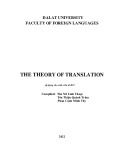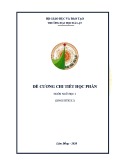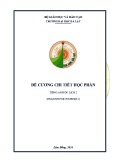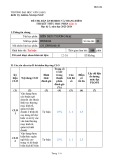
Translating business contract into compliant business processes
Z. Milosevic
1
, S. Sadiq, M. Orlowska,
1
Also with Deontik, Australia (www.deontik.com)
School of Information Technology and Electrical Engineering,
The University of Queensland,
Brisbane, QLD 4072, Australia.
{zoran, maria, shazia}@itee.uq.edu.au
Abstract
This paper presents an approach for translating legalese
expression of business contracts into candidate business
activities and processes while ensuring their compliance
with contract. This is a progressive refinement using logic-
based formalism to capture contract semantics and to serve
as an intermediate step for transformation. Particular value
of this approach is for those organisations that consider
moving towards new approaches to enterprise contract
management and applying them to their future contracts.
Keywords: Business Contracts, Internal Business
Processes, Collaborative Business Processes.
1. Introduction
Business processes have been traditionally designed with
the aim of achieving some internal goals such as an
increasing efficiency or reduction of cost in performing
internal business activities. In doing so, businesses were
focusing on optimal design (or indeed redesign) of their
internal processes. Increasingly however, business process
designers are becoming cognisant of a need to consider
external influences such as the impact of regulatory
compliance requirements or the role of business contracts
as governing mechanism for cross-organisational
interactions.
In order to provide an explicit support for linking
processes with external constraints, there is a need to start
discovering and documenting rules and patterns that could
be applied when trying to map such external constraints
onto the design of business processes. This is of particular
importance for processes crossing organisational
boundaries.
The aim of this paper is to provide a first step in this
direction, by proposing an approach which can be used to
progressively transform legalese version of contract into
business activities and processes, complaint with the
contract and in a form which is executable by the
underlying process engines. Our current focus is on
considering the constraints from business contracts, but the
analysis is quite generic so that it can be applied more
broadly, in terms of any kind of external constraints.
The next section provides discussion about legalese form
of contracts and different types of contract conditions in
such forms. Section 3 introduces an example that will be
used to illustrate various concepts and ideas in the rest of
the paper. This is followed by the description of a contract
formalism, which we call a Formal Contract Language
(FCL), first introduced in [6], but taking into account
significant prior research results of a series of authors [3],
[5], [8]. The subsequent section presents our transformation
approach and provides several discussion points. The paper
concludes with a list of key findings and an outline of
several future research directions.
2. Contracts – key legalese structures
From a system-theoretic point of view, a contract is an
agreement that specifies part of the collective behaviour of
two or more objects [19]. In the world of law, these objects
can be trading partners (individuals or organisations)
considered as legal entitles and the agreement reflects their
mutual promises, commitments and expectations while
being enforceable by law. The behaviour of an object may
involve many other aspects of behaviour, either internal
behaviour or interactions with other objects which are
subject to other agreements and contracts.

From a legal point of view, the contract-governed part of
the collective behaviour can typically be expressed through
one or more of the legally-centric types of contract
conditions. We have identified several categories of such
conditions or legalese structures:
1. The declaration of pre-existing external constraints
from the environment which apply to the contract as a
whole or to the variables in the contract. These for
example may be rules and policies from various types
of law, such as taxation law, employment law or
business contracts law;
2. Definitional expressions explaining meaning of certain
terms in contracts, e.g. that price is nominated in the
Australian dollars;
3. The declaration of a period of validity when the
contract is in effect or a duration for the contract;
4. The statement of core normative policies such as
obligations, permissions and prohibitions [9] that apply
to the parties involved, either directly from the contract
in question or from the environment, as per category 1
above. Note that in the contracts, the core normative
policies will typically apply to a subject of a policy but
will often mention a target or beneficiary of the policy;
in cases where a beneficiary is omitted, it may be
inferred from the context. In the deontic logic
literature, if a normative policy explicitly mentions one
or both of the subject or target, they are referred to as
directed modalities and if neither of these was
mentioned the deontic statement is referred to as a
general modality. Further, obligation policies can be of
two types, one representing high-level policies,
typically stating a goal to be achieved and lower level
policies which explicitly state actions of a subject;
5. The statement of other enterprise policies that reflect
typical terms used by business and which can mostly
be reduced on the core policies above; we refer to
these as compound normative policies; examples are
the concepts of rights, liabilities, commitment and
responsibility;
6. The statement of policy-related actions that cover
transfer of normative modalities between principals
and agents, such as various forms of delegation; in this
paper we call them policy-transfer (delegation) actions;
7. The specification of events that signify occurrence of
violations of the policies or the events that signify
situations that could potentially lead to some violations
in future; in this paper we call them attention events;
8. Second-effect policies to be invoked in cases of
violations of any of the above policies; we call these
reparation policies, as per [8];
9. The expression of force-majeure conditions, explaining
circumstances which are beyond control of either
parties; these need to be mentioned, although they
might not be able to invoke of any subsequent
measures;
10. A number of structuring constructs introduced for the
purposes of grouping these expressions and supporting
reuse of the existing fragments, e.g. a contract clause
can consist of a number of other legal statements.
The legalese structures above can be combined in
various ways to reflect the specific circumstances that apply
to the contract in question.
3. Example
This section introduces an example of a contract which
will be used to highlight key concepts mentioned above and
to illustrate other ideas as they are introduced in subsequent
sections. The example is mostly based on our earlier
scenario presented in [18].
Consider a contract between an Outback Water (OW)
company that provides irrigation water to a number of
different customers encompassing agriculture, industry
(primarily mining and oil/gas extraction) and small towns
in a central part of Australia. The OW operates storage
lakes feeding into both open irrigation canals and pipelines,
some of which are hundreds of kilometres in length. The
OW irrigation system can be monitored remotely and the
system includes many pumps and other assets that need
constant monitoring and maintenance.
The OW has chosen a subcontractor to provide
maintenance services for various assets in the water system.
The terms of engagement are formalised by a legal con-
tract that will govern interactions between the OW and the
selected subcontractor. The contract provides legal binding
between parties and each party has an obligation to satisfy
the contract conditions by appropriately implementing their
business processes during the term of the contract.
The agreed contract will thus specify conditions for
maintenance subcontractors to service and maintain pumps
and related equipment in various facilities operated by OW.
It is expected that the relationship between OW and the
subcontractor will have a long-term nature, but the contract
will be initially for a year and will apply to a specific list of
assets that are to be maintained.
This maintenance service contract is given next.

MAINTENANCE SERVICE CONTRACT
This Deed of Agreement is entered into as of the Effective
Date identified below.
BETWEEN Outback Water (To be known as the OW) AND
OZ Pumps (To be known as the Subcontractor)
WHEREAS (OW) enters into an agreement with
(Subcontractor) for Maintenance Services, to be known as
(Service) subject to the following terms and conditions:
1 Definitions and Interpretations
1.1 Price is a reference to the currency of the Australia
unless otherwise stated.
1.2 This agreement is governed by Australia law and the
parties hereby agree to submit to the jurisdiction of the
Courts of the Queensland with respect to this
agreement.
1.3 MTBF is Mean Time Between Failures and MTTR is
Mean Time To Repair
2 Commencement and Completion
2.1 The commencement date is scheduled as January
30, 2006.
2.2 The completion date is scheduled as January 30,
2007.
2.3 The (OW) shall notify the (Subcontractor) of
possibility of extension for 1 year by 3
rd
quarter of the
contract
3 Service and QoS Delivery
3.1 The (Subcontractor) shall make its best efforts to
ensure that the following QoS conditions are met:
- not exceed the maximum asset down time on any one
asset
- not exceed the call-out time limit on more than 5% of
emergencies in a month
- average above the specified MTBF and below the
MTTR over a month
The maximum or minimum values are provided in
schedule A of the contract.
3.2 (Subcontractor must inform (OW) within 24 hours of
any event that might affect the ability to achieve the
quality of service, e.g. resignation of subcontractor
engineers, recurring problem with certain asset types
3.3. The (Subcontractor) shall not re-assign
maintenance to another party, i.e. Sub-Subcontractor
3.4. The (OW) will provide access to all asset sites
based on service requirements
4 Reports and notifications
4.1 The (Subcontractor) will submit monthly reports on
all preventative maintenance activities and emergency
events, including full timing details and description of
problems and action taken, broken down into labour,
parts and materials.
4.2 The (OW) will provide list of assets to be maintained,
with clear instructions of the maintenance cycles
required (asset lists are in a schedule to the contract,
maintenance manuals are in associated paper or on-line
documents)
4.3 The (OW) will provide clear MTBF and MTTR targets
4.4 The (OW) will provide feed back to the subcontractor
any information received about problems with the water
supply, including emergencies reported by its customers
within 24 hours
4.5 After each of the 1st and 2nd quarters, the (OW) will
give guidance to the subcontractor on how any
shortcomings in the service might be improved.
5 Payment
5.1 The (Subcontractor) shall submit monthly invoices to
(OW) for services performed during that period
5.2. The (OW) shall make full payment of
(Subcontractor) invoices within 30 days of receipt
6 Termination
6.1 The (OW) can terminate the contract after three QoS
violations
The contract above is structured in terms of the clause
groups according to the legalese structures above, namely
in terms of:
• Definitional clauses (Clause Group 1), stating the
external laws and policies that need to be obeyed,
and explaining the meaning of some variables
applicable to many assets, such as Mean Time
Between Failures (MTBF) and Mean Time To
Repair (MTTR).
• Commencement and completion clauses (Clause
Group 2), defining the validity of the contract and
conditions for its renewal
• Service delivery clauses, including Quality of
Service (QoS) clauses (Clause Group 3), stating
QoS and other service conditions that need to be
provided by the subcontractor, in consideration for
payment for their services; these clauses may also
include conditions that apply to the OW company in
ensuring that certain preconditions needed for the
subcontractor are also met. This section of contract
contains most of the core normative (or deontic)
expressions that apply to the main service delivery
by the Subcontractor.
• Reporting and notification clauses (Clause Group
4), referring to the obligations of each party in either
making available some documents (by the OW) or
producing reports during the maintenance process
(by the subcontractor) as part of regular
maintenance processes; these clauses would also
describe the notifications that need to be sent by
either party to indicate some potential problem or
emergency situation.
• Payment clauses (Clause Group 5), stating different
conditions needing to be fulfilled for payment
processes
• Termination clauses (Clause Group 6) stating
permissions under which parties can terminate the
contract.

4. Contract formalism
The identification of several categories of legalese
contract expression above is a step towards a more
structured way of representing contracts. This structuring
provides a better starting point for considering the use of
several existing logics and/or normative systems theories to
arrive at a formal (i.e. logic) representation of contracts.
Example of such logics are modal, deontic and temporal
logic, along with a recently proposed logic of violations [5].
In many respects the scope of normative systems overlaps
with the scope of these logics. This is because they analyse
those systems whose behaviour is covered by a set of
norms, being statements of constraints on expected
behaviour such as what behaviour is allowed, what
behaviour must not occur, what behaviour is required and
so on.
4.1 From legalese structures to deontic constraints
A detailed examination of the semantics of the contract
conditions above reveals that their legal intent and form are
closely related to various types of behavioural expressions
that apply to the parties in contract. Most of these
behavioural expressions are in the form of core normative
policies (or deontic modalities), the core of which are
obligations, permissions and prohibitions.
Deontic constraints express what parties to the contact
are required to perform (obligations), what they are allowed
to do (permissions), or what they are not allowed to do
(prohibitions).
In general, deontic constraints apply to the behaviour of
actors playing roles in some policy context (contract being
a special case of a set of policies). This context is typically
determined by the way the roles are configured into
collaborative structures and by the pre-existing constraints
from the environment of this context space. In the specific
case of legal contracts, this context is the contract itself,
consisting of various types of contract conditions as
discussed above, all of which will apply to the two or more
roles specified in the contract. These roles in turn could be
played by different legal entities, and policies apply to these
legal entities when they accept the constraints of the
respective roles.
Deontic constraints are structured in terms of:
• constraints on behaviour typically expressed in
terms of events and relationship between events,
closely reflecting the specification of various
policies as part of contract conditions. The event
(relationship) constraint describes the expected
behaviour of the party in question. Events describe
the actions of the parties that are subject to the
constraint, but also other occurrences such as
expiration of deadlines, or actions of other parties.
• the specification of the modality that applies to the
party, e.g. an obligation, permission or prohibition.
• a subject to which modality and behavioural
constraints apply. A deontic modality may explicitly
identify a beneficiary (or target) from the subject
side in a modality expression, although the
beneficiary may be implied from the contract.
• Triggering conditions which signify that notmative
policies are in force; these can be temporal events,
but also other events, such as violation of other
policies.
The semantics of modality can be expressed in terms of
a set of observations chosen to determine whether the
corresponding policy is satisfied or not. For example, the
prohibition modality can be checked through an observation
of occurrence(s) which are contrary to the prohibition
statement.
Note that the style of constraints in deontic expressions
is different from the style of expressions in traditional
business process specification languages. The focus of the
process languages is on the description of control and data
flows to support repeatable and automatable activities. A
lesser emphasis is given to the detailed description of
various types of associations between roles and process
activities, and no emphasis is normally given to the
organizational consequences of the violations of agreed
behaviour.
Recent business process specifications, however, are
increasingly adopting an event-based style of behaviour
which better suits needs for more flexibility such as real-
time process adaptations. Events can be used to determine
process flows in real-time as a result of the outcome of a
specific task or to generate notifications of specific events
(e.g. natural events or temporal events) or the recognition of
an emerging economic or market trend.
We believe that the event-oriented style of expression is
suitable for the expression of deontic constraints and the
emerging business processes specifications centred on the
flow of events can be exploited as a mechanism to facilitate
the derivation of business processes compliant with contract
conditions.
4.2 From deontic constraints to contract
formalism
This section presents a formalism for describing deontic
constraints, based on commonly accepted principles of
deontic logic, but extended with the formalism for treating
violations. The formalism, called the Formal Contract

Language (FCL) was first presented in [6], and is based on
the logic of violations developed by Governatori and
Rotolo [5], used to represent violation in contracts.
4.2.1. Formalising deontic constraints
Deontic logic extends first order logic with the modal
operators O, P and F denoting obligations, permissions and
prohibitions. The modal operators satisfy the following
deontic relationships:
OA ¬ P¬ A ¬ O¬ A PA O¬ A FA ¬ PA FA.
The modal operators also satisfy the following
relationship OA PA, meaning that if A is obligatory, then
A is permitted. This relationship can be used to ensure
checking of the internal consistency of the obligations in
contracts: it is possible to execute obligations without doing
something that is forbidden.
As stated before, the deontic constraints in contracts
apply to the roles involved in the contract, specifically to
the subject to which constraints apply, and possibly
including the target or beneficiary. In case of obligation this
can be denoted using the expression O
s
A to be read as ‘s has
the obligation to do A’, or ‘A is obligatory for s’. If a
beneficiary is mentioned, the expression is extended, i.e.
O
s,b
to be read as ‘s has the obligation to do A with respect
to b’.
In case of certain breaches of polices in contract by
actors playing the roles in a contract, special policies may
be included to express the respective obligations for these
actors. These policies can vary from pecuniary penalties to
the termination of the contract itself. In deontic logic, this
type of expression, namely the activation of certain
obligations in case of other obligations being violated, is
referred to as contrary-to-duty obligations (CTD) or
reparation obligations. The reparation obligations are in
force only when normative violations occur and are meant
to `repair' violations of primary obligations. Thus a
reparation policy is a conditional obligation arising in
response to a violation, where a violation is signalled by an
unfulfilled obligation. The expression of violation
conditions and the reparation obligations is an important
requirement for formalising contracts, design subsequent
business processes to minimise or deal with such violations
and also to support the monitoring of business contracts
There are a number of different approaches in deontic
logic to formalise CTD obligations, but in this paper we use
a simple logic of violation, to avoid danger of logical
paradoxes that some other approaches may involve [3].
This logic is also suitable to model chains of violations and
is described next.
4.2.2. Formalising violations of deontic constraints
In addition to using the logic based approach to
specifying core deontic constraints, we thus provide a
simple logic of violation.
The violation expression consists of the primary
obligation, its violation conditions, an obligation generated
upon the violation condition occurs, and this can
recursively be iterated, until the final condition is reached.
This final condition is one which cannot be violated and
this it is to be a permission. We introduce the non-boolean
connective
, whose interpretation is such that OA
OB is
read as “OB is the reparation of the violation of OA”. In
other words the interpretation of OA
OB, is that A is
obligatory, but if the obligation OA is not fulfilled (i.e.,
when ¬ A is the case, thus resulting in a violation of the
obligation OA), then the obligation OB is activated and
becomes in force until it is satisfied or violated. In the latter
case a new obligation may be activated, followed by others
in chain, as appropriate.
4.2.3. Formal Contract Language (FCL)
The FCL brings together two set of atomic symbols: a
numerable set of propositional letters p,q,r,..., intended to
represent the state variables of a contract and a numerable
set of event symbols , , , ... corresponding to the
relevant events in a contract. Formulas of the logic are
constructed using the deontic operators O, P, negation ¬
and the non-boolean connective
(for the reparation
operator).
The formulas of FCL will be constructed in two steps
according to the following formation rules:
- every propositional letter is a literal;
- every event symbol is a literal;
- the negation of a literal is a literal;
- if X is a deontic operator and l is a literal then Xl and ¬ Xl
are modal literals.
We now use the following set of formation rules to
introduce
-expressions, i.e., the formulas used to encode
chains of obligations and violations:
- every modal literal is an
-expression;
- if Ol
1
,...,Ol
n
are modal literals and l
n+1
is a literal, then Ol
1
…
Ol
n
and Ol
1
…
Ol
n
Pl
n+1
are
-
expressions.
Each condition or policy of a contract is represented by a
rule in FCL, where a rule is an expression
r:A
1
,...,A
n
C
r is the name/id of the policy, A
1
,...,A
n
, (the antecedent of







![Đề cương chi tiết Tiếng Anh thương mại 2 (Business English 2) - Trường ĐH Đà Lạt [Mới nhất]](https://cdn.tailieu.vn/images/document/thumbnail/2025/20250212/tuetuebinhan666/135x160/7211739332500.jpg)





![Trắc nghiệm Tiếng Anh kinh doanh: Bài test chuẩn và [từ mô tả phù hợp]](https://cdn.tailieu.vn/images/document/thumbnail/2025/20251102/ngocanhn201@gmail.com/135x160/51201762135116.jpg)








![Đề cương ôn tập Tiếng Anh du lịch (English for Tourism) [mới nhất]](https://cdn.tailieu.vn/images/document/thumbnail/2025/20250728/kimphuong1001/135x160/55271753673317.jpg)



